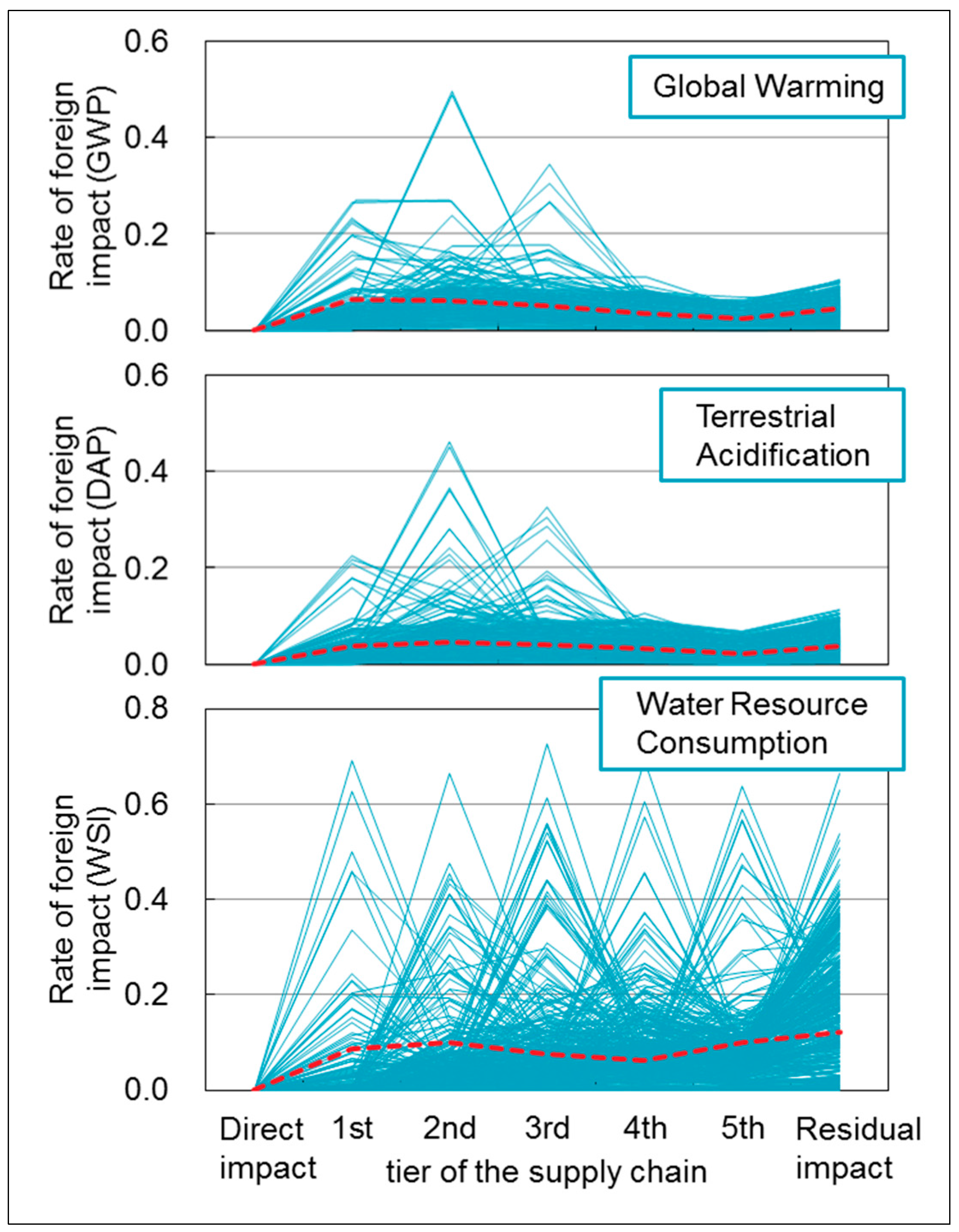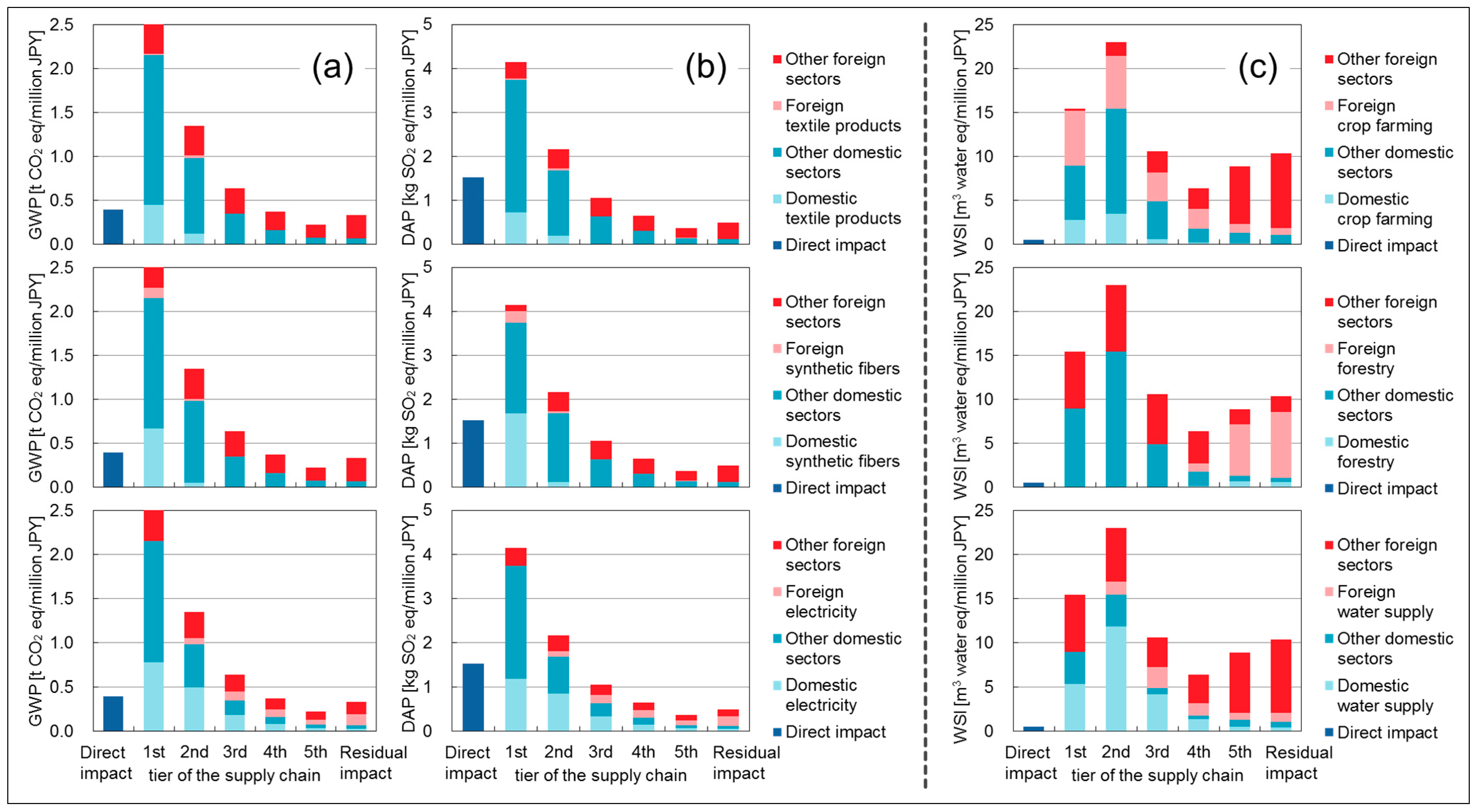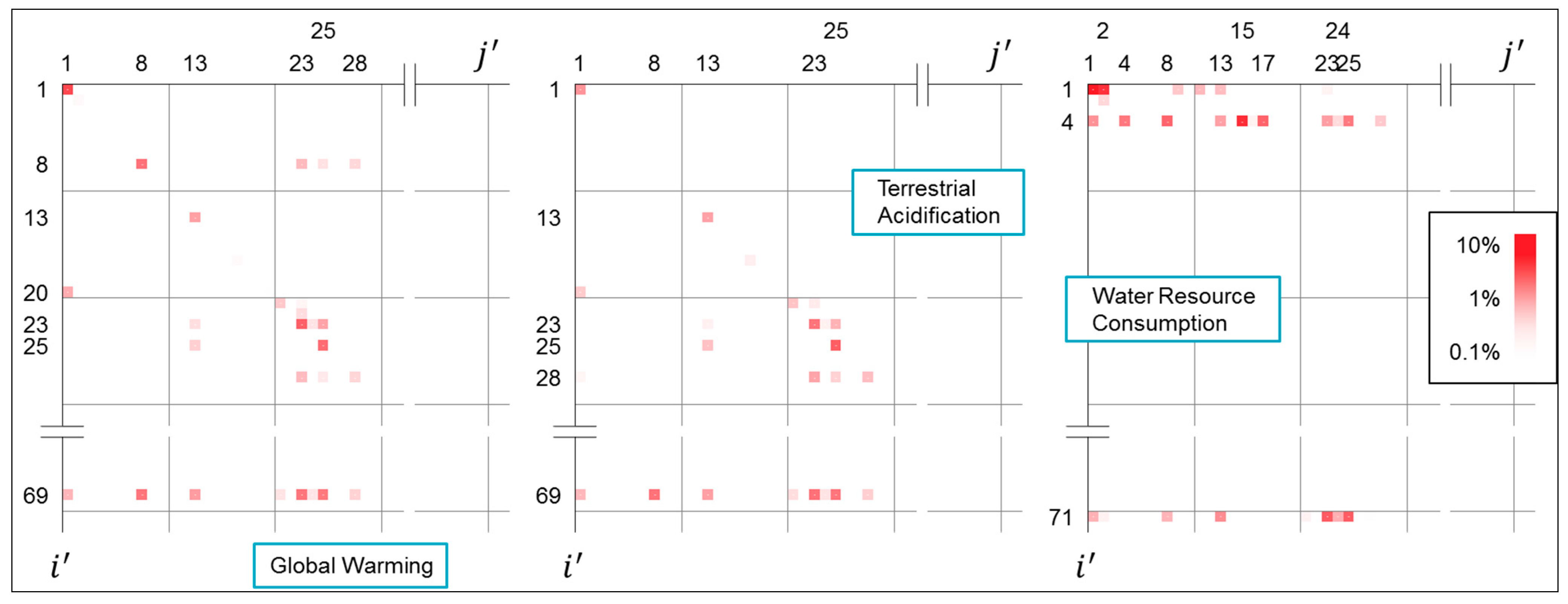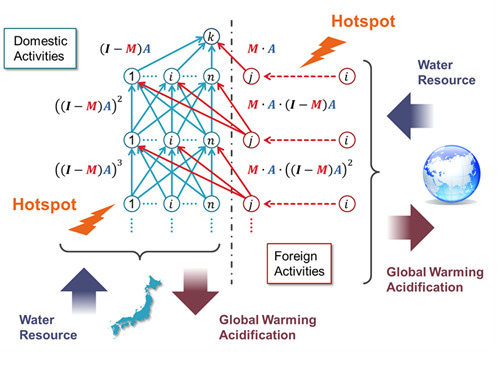A Practical Approach to Screening Potential Environmental Hotspots of Different Impact Categories in Supply Chains
Abstract
:1. Introduction
2. Materials and Methods
2.1. Embodied Intensities
2.2. Unit Direct Interventions
2.3. Characterization Factors
| GWP 100 of the SAR [29] | Ref.) GWP 100 of the AR4 [33] | DAP [30] (Japan Average) | WSI [31] (Japan) |
|---|---|---|---|
| (kg·CO2·eq/kg) | (kg·CO2·eq/kg) | (kg·SO2·eq/kg) | (m3·water·eq/m3) |
| CO2: 1 | CO2: 1 | NO2: 0.63 | Surface water (S2b): 0.536 |
| CH4: 21 | CH4: 25 | SO2: 1.00 | Ground water (G2b): 0.024 |
| N2O: 310 | N2O: 298 | Rain water: 0.999 | |
| HFCs: 1300 a etc. | HFCs: 1430 a, etc. | ||
| PFCs: 6500 b etc. | PFCs: 7390 b, etc. | ||
| SF6: 23,900 | SF6: 22,800 |
2.4. Domestic and Foreign Potential Impacts by Each Tier of the Supply Chain
2.5. Potential Impacts Associated with the Import of Raw Materials
3. Results
3.1. Rates of Foreign Potential Impacts

3.2. Product Subject to a Case Study
3.3. Domestic and Foreign Potential Impacts by Each Tier of the Supply Chain
3.4. Sectors that Significantly Contribute to Potential Impacts

3.5. Potential Impacts that Associated with the Import of Raw Materials

4. Discussion
Supplementary Files
Supplementary File 1Acknowledgments
Author Contributions
Conflicts of Interest
References
- Wible, B.; Mervis, J.; Wigginton, N.S. Rethinking the Global Supply Chain. Science 2014, 344, 1100–1103. [Google Scholar] [CrossRef] [PubMed]
- Dooley, K.J. The Whole Chain. Science 2014. [Google Scholar] [CrossRef] [PubMed]
- Hellweg, S.; Milà i Canals, L. Emerging Approaches, Challenges and Opportunities in Life Cycle Assessment. Science 2014, 344, 1109–1113. [Google Scholar] [CrossRef] [PubMed]
- Greenhouse Gas Protocol (GHG) Protocol. Corporate Value Chain (Scope 3) Accounting and Reporting Standard. Available online: http://www.ghgprotocol.org/standards/scope-3-standard (accessed on 11 June 2015).
- Greenhouse Gas Protocol (GHG) Protocol. Technical Guidance for Calculating Scope 3 Emissions, Version 1.0. Available online: http://www.ghgprotocol.org/feature/scope-3-calculation-guidance (accessed on 11 June 2015).
- International Organization for Standardization (ISO). ISO/TR 14069: 2013, Greenhouse Gases–Quantification and Reporting of Greenhouse Gas Emissions for Organizations—Guidance for the Application of ISO 14064-1. Available online: http://www.iso.org/iso/catalogue_detail.htm?csnumber=43280 (accessed on 11 June 2015).
- Carbon Disclosure Project (CDP). Supply Chain Report 2013–14: Collaborative Action on Climate Risk. Available online: https://www.cdp.net/en-US/Results/Pages/Supply-Chain-Reports.aspx (accessed on 11 June 2015).
- European Commission (EC). Commission Recommendation of 9 April 2013 on the Use of Common Methods to Measure and Communicate the Life Cycle Environmental Performance of Products and Organisations. Available online: http://eur-lex.europa.eu/legal-content/EN/TXT/?uri=CELEX:32013H0179 (accessed on 11 June 2015).
- Berger, M.; Finkbeiner, M. Water Footprinting: How to Address Water Use in Life Cycle Assessment? Sustainability 2010, 2, 919–944. [Google Scholar] [CrossRef]
- International Organization for Standardization (ISO). ISO 14046: 2014, Environmental Management–Water Footprint–Principles, Requirements and Guidelines. Available online: http://www.iso.org/iso/catalogue_detail?csnumber=43263 (accessed on 11 June 2015).
- Suh, S.; Huppes, G. Methods for Life Cycle Inventory of a Product. J. Cleaner Prod. 2005, 13, 687–697. [Google Scholar] [CrossRef]
- Wiedmann, T. A Review of Recent Multi-Region Input–Output Models Used for Consumption-based Emission and Resource Accounting. Ecol. Econ. 2009, 69, 211–222. [Google Scholar] [CrossRef]
- Peters, G.P.; Hertwich, E.G. CO2 Embodied in International Trade with Implication for Global Climate Policy. Environ. Sci. Technol. 2008, 42, 1401–1407. [Google Scholar] [CrossRef] [PubMed]
- EXIOBASE. Available online: http://www.exiobase.eu/ (accessed on 11 June 2015).
- Lenzen, M.; Moran, D.; Kanemoto, K.; Geschke, A. Building Eora: A Global Multi-Region Input–Output Database at High Country and Sector Resolution. Econ. Syst. Research 2013, 25, 20–49. [Google Scholar] [CrossRef]
- Nansai, K.; Kondo, Y.; Kagawa, S.; Suh, S.; Nakajima, K.; Inaba, R.; Tohno, S. Estimates of Embodied Global Energy and Air-Emission Intensities of Japanese Products for Building a Japanese Input–Output Life Cycle Assessment Database with a Global System Boundary. Environ. Sci. Technol. 2012, 46, 9146–9154. [Google Scholar] [CrossRef] [PubMed]
- Ewing, B.R.; Hawkins, T.R.; Wiedmann, T.O.; Galli, A.; Ercin, A.E.; Weinzettel, J.; Steen-Olsen, K. Integrating Ecological and Water Footprint Accounting in a Multi-Regional Input–Output Framework. Ecol. Indic. 2012, 23, 1–8. [Google Scholar] [CrossRef]
- Hauschild, M.; Goedkoop, M.; Guinée, J.B.; Heijungs, R.; Huijbregts, M.; Jolliet, O.; Margni, M.; de Schryver, A.; Humbert, S.; Laurent, A.; et al. Identifying Best Existing Practice for Characterization Modeling in Life Cycle Impact Assessment. Int. J. Life Cycle Assess. 2013, 18, 683–697. [Google Scholar] [CrossRef]
- Finnveden, G.; Hauschild, M.Z.; Ekvall, T.; Guinée, J.; Heijungs, R.; Hellweg, S.; Koehler, A.; Pennington, D.; Suh, S. Recent Developments in Life Cycle Assessment. J. Environ. Manag. 2009, 91, 1–21. [Google Scholar] [CrossRef] [PubMed]
- Kounina, A.; Margni, M.; Bayart, J.B.; Boulay, A.M.; Berger, M.; Bulle, C.; Frischknecht, R.; Koehler, A.; Milà i Canals, L.; Motoshita, M.; et al. Review of Methods Addressing Freshwater Use in Life Cycle Inventory and Impact Assessment. Int. J. Life Cycle Assess. 2013, 18, 707–721. [Google Scholar] [CrossRef]
- Acquaye, A.A.; Wiedmann, T.; Feng, K.; Crawford, R.H.; Barrett, J.; Kuylenstierna, J.; Duffy, A.P.; Koh, S.C.L.; McQueen-Mason, S. Identification of ‘Carbon Hot-Spots’ and Quantification of GHG Intensities in the Biodiesel Supply Chain Using Hybrid LCA and Structural Path Analysis. Environ. Sci. Technol. 2011, 45, 2471–2478. [Google Scholar] [CrossRef] [PubMed]
- Pfister, S.; Bayer, P.; Koehler, A.; Hellweg, S. Environmental Impacts of Water Use in Global Crop Production: Hotspots and Trade-Offs with Land Use. Environ. Sci. Technol. 2011, 45, 5761–5768. [Google Scholar] [CrossRef] [PubMed]
- Miller, R.E.; Blair, P.D. Foundations of Input–Output Analysis. In Input–Output Analysis: Foundations and Extensions, 2nd ed.; Cambridge University Press: Cambridge, UK, 2009; pp. 10–68. [Google Scholar]
- National Institute of Environmental Studies, Japan (NIES). 3EID: Embodied Energy and Emission Intensity Data for Japan Using Input-Output Tables. Available online: http://www.cger.nies.go.jp/publications/report/d031/eng/index_e.htm (accessed on 11 June 2015).
- Statistics Bureau, Japan. 2005 Input–Output Tables for Japan. Available online: http://www.stat.go.jp/english/data/io/io05.htm (accessed on 11 June 2015).
- Nansai, K.; Moriguchi, Y.; Tohno, S. Compilation and Application of Japanese Inventories for Energy Consumption and Air Pollutant Emissions Using Input–Output Tables. Environ. Sci. Technol. 2003, 37, 2005–2015. [Google Scholar] [CrossRef] [PubMed]
- Ono, Y.; Horiguchi, K.; Itsubo, N. Development of Water Footprint Inventory Database Using Input-Output Analysis in Japan. J. Life Cycle Assess. Jpn. 2013, 9, 108–115. [Google Scholar] [CrossRef]
- Itsubo, N.; Laboratory, Tokyo City University. Database of the Amounts of Water Use & Consumption, Ver. 2. Available online: http://www.yc.tcu.ac.jp/~itsubo-lab/research/water_db.html (accessed on 11 June 2015).
- Intergovernmental Panel on Climate Change (IPCC). Climate Change 1995: The Science of Climate Change, Contribution of Working Group I to the Second Assessment Report of the Intergovernmental Panel on Climate Change. Available online: http://www.ipcc.ch/publications_and_data/publications_and_data_reports.shtml (accessed on 11 June 2015).
- Itsubo, N.; Inaba, A. LIME 2: Life-cycle Impact assessment Method based on Endpoint modeling, JLCA Newsletter, Nos. 12–17, 2012–2014. Available online: http://lca-forum.org/english/ (accessed on 11 June 2015).
- Interuniversity Research Centre for the Life Cycle of Products, Processes and Services (CIRAIG). WaterUseImpacts. Available online: http://www.ciraig.org/fr/wateruseimpacts.php (accessed on 11 June 2015).
- Boulay, A.M.; Bulle, C.; Bayart, J.B.; Deschênes, L.; Margni, M. Regional Characterization of Freshwater Use in LCA: Modeling Direct Impacts on Human Health. Environ. Sci. Technol. 2011, 45, 8948–8957. [Google Scholar] [CrossRef] [PubMed]
- Solomon, S.; Qin, D.; Manning, M.; Chen, Z.; Marquis, M.; Averyt, K.B.; Tignor, M.; Miller, H.L. (Eds.) Climate Change 2007: The Physical Science Basis, Contribution of Working Group I to the Fourth Assessment Report of the Intergovernmental Panel on Climate Change. Available online: http://www.ipcc.ch/publications_and_data/ar4/wg1/en/contents.html (accessed on 11 June 2015).
- Lenzen, M. Structural Path Analysis of Ecosystem Networks. Ecol. Modell. 2007, 200, 334–342. [Google Scholar] [CrossRef]
- Ministry of Finance, Japan (MOF). Trade Statistics of Japan. Available online: http://www.customs.go.jp/toukei/info/index_e.htm (accessed on 11 June 2015).
- Benoît Norris, C. Data for Social LCA. Int. J. Life Cycle Assess. 2014, 19, 261–265. [Google Scholar] [CrossRef]
- Onat, N.C.; Kucukvar, M.; Tatari, O. Integrating Triple Bottom Line Input–Output Analysis into Life Cycle Sustainability Assessment Framework: the Case for US Buildings. Int. J. Life Cycle Assess. 2014, 19, 1488–1505. [Google Scholar] [CrossRef]
© 2015 by the authors; licensee MDPI, Basel, Switzerland. This article is an open access article distributed under the terms and conditions of the Creative Commons Attribution license (http://creativecommons.org/licenses/by/4.0/).
Share and Cite
Nakatani, J.; Maruyama, T.; Fukuchi, K.; Moriguchi, Y. A Practical Approach to Screening Potential Environmental Hotspots of Different Impact Categories in Supply Chains. Sustainability 2015, 7, 11878-11892. https://doi.org/10.3390/su70911878
Nakatani J, Maruyama T, Fukuchi K, Moriguchi Y. A Practical Approach to Screening Potential Environmental Hotspots of Different Impact Categories in Supply Chains. Sustainability. 2015; 7(9):11878-11892. https://doi.org/10.3390/su70911878
Chicago/Turabian StyleNakatani, Jun, Tamon Maruyama, Kosuke Fukuchi, and Yuichi Moriguchi. 2015. "A Practical Approach to Screening Potential Environmental Hotspots of Different Impact Categories in Supply Chains" Sustainability 7, no. 9: 11878-11892. https://doi.org/10.3390/su70911878
APA StyleNakatani, J., Maruyama, T., Fukuchi, K., & Moriguchi, Y. (2015). A Practical Approach to Screening Potential Environmental Hotspots of Different Impact Categories in Supply Chains. Sustainability, 7(9), 11878-11892. https://doi.org/10.3390/su70911878







